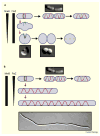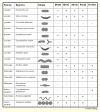Sculpting the bacterial cell
- PMID: 19906583
- PMCID: PMC4080913
- DOI: 10.1016/j.cub.2009.06.033
Sculpting the bacterial cell
Abstract
Prokaryotes come in a wide variety of shapes, determined largely by natural selection, physical constraints, and patterns of cell growth and division. Because of their relative simplicity, bacterial cells are excellent models for how genes and proteins can directly determine morphology. Recent advances in cytological methods for bacteria have shown that distinct cytoskeletal filaments composed of actin and tubulin homologs are important for guiding growth patterns of the cell wall in bacteria, and that the glycan strands that constitute the wall are generally perpendicular to the direction of growth. This cytoskeleton-directed cell wall patterning is strikingly reminiscent of how plant cell wall growth is regulated by microtubules. In rod-shaped bacilli, helical cables of actin-like MreB protein stretch along the cell length and orchestrate elongation of the cell wall, whereas the tubulin-like FtsZ protein directs formation of the division septum and the resulting cell poles. The overlap and interplay between these two systems and the peptidoglycan-synthesizing enzymes they recruit are the major driving forces of cylindrical shapes. Round cocci, on the other hand, have lost their MreB cables and instead must grow mainly via their division septum, giving them their characteristic round or ovoid shapes. Other bacteria that lack MreB homologs or even cell walls use distinct cytoskeletal systems to maintain their distinct shapes. Here I review what is known about the mechanisms that determine the shape of prokaryotic cells.
Figures




Similar articles
-
Processive movement of MreB-associated cell wall biosynthetic complexes in bacteria.Science. 2011 Jul 8;333(6039):225-8. doi: 10.1126/science.1203466. Epub 2011 Jun 2. Science. 2011. PMID: 21636744
-
Molecules of the bacterial cytoskeleton.Annu Rev Biophys Biomol Struct. 2004;33:177-98. doi: 10.1146/annurev.biophys.33.110502.132647. Annu Rev Biophys Biomol Struct. 2004. PMID: 15139810 Review.
-
Cell Cycle Machinery in Bacillus subtilis.Subcell Biochem. 2017;84:67-101. doi: 10.1007/978-3-319-53047-5_3. Subcell Biochem. 2017. PMID: 28500523 Free PMC article. Review.
-
The evolution of spherical cell shape; progress and perspective.Biochem Soc Trans. 2019 Dec 20;47(6):1621-1634. doi: 10.1042/BST20180634. Biochem Soc Trans. 2019. PMID: 31829405 Free PMC article. Review.
-
Distinct cytoskeletal proteins define zones of enhanced cell wall synthesis in Helicobacter pylori.Elife. 2020 Jan 9;9:e52482. doi: 10.7554/eLife.52482. Elife. 2020. PMID: 31916938 Free PMC article.
Cited by
-
Teichoic acids anchor distinct cell wall lamellae in an apically growing bacterium.Commun Biol. 2020 Jun 17;3(1):314. doi: 10.1038/s42003-020-1038-6. Commun Biol. 2020. PMID: 32555532 Free PMC article.
-
The cyst-dividing bacterium Ramlibacter tataouinensis TTB310 genome reveals a well-stocked toolbox for adaptation to a desert environment.PLoS One. 2011;6(9):e23784. doi: 10.1371/journal.pone.0023784. Epub 2011 Sep 1. PLoS One. 2011. PMID: 21912644 Free PMC article.
-
Deformation of filamentous Escherichia coli cells in a microfluidic device: a new technique to study cell mechanics.PLoS One. 2014 Jan 2;9(1):e83775. doi: 10.1371/journal.pone.0083775. eCollection 2014. PLoS One. 2014. PMID: 24392095 Free PMC article.
-
What determines cell size?BMC Biol. 2012 Dec 14;10:101. doi: 10.1186/1741-7007-10-101. BMC Biol. 2012. PMID: 23241366 Free PMC article. No abstract available.
-
Host-Polarized Cell Growth in Animal Symbionts.Curr Biol. 2018 Apr 2;28(7):1039-1051.e5. doi: 10.1016/j.cub.2018.02.028. Epub 2018 Mar 22. Curr Biol. 2018. PMID: 29576473 Free PMC article.
References
Publication types
MeSH terms
Substances
Grants and funding
LinkOut - more resources
Full Text Sources
Miscellaneous

